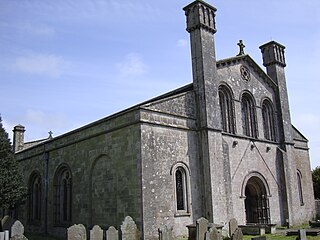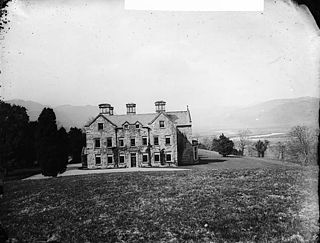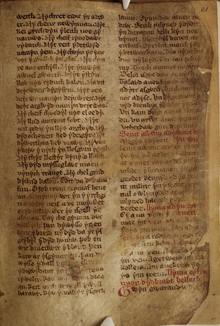
The Red Book of Hergest, Oxford, Jesus College, MS 111, is a large vellum manuscript written shortly after 1382, which ranks as one of the most important medieval manuscripts written in the Welsh language. It preserves a collection of Welsh prose and poetry, notably the tales of the Mabinogion and Gogynfeirdd poetry. The manuscript derives its name from the colour of its leather binding and from its association with Hergest Court between the late 15th and early 17th century.

The National Library of Wales, in Aberystwyth, is the national legal deposit library of Wales and is one of the Welsh Government sponsored bodies. It is the biggest library in Wales, holding over 6.5 million books and periodicals, and the largest collections of archives, portraits, maps, and photographic images in Wales. The Library is also home to the national collection of Welsh manuscripts, the National Screen and Sound Archive of Wales, and the most comprehensive collection of paintings and topographical prints in Wales. As the primary research library and archive in Wales and one of the largest research libraries in the United Kingdom, the National Library is a member of Research Libraries UK (RLUK) and the Consortium of European Research Libraries (CERL).
The Hengwrt Chaucer manuscript is an early-15th-century manuscript of the Canterbury Tales, held in the National Library of Wales, in Aberystwyth. It is an important source for Chaucer's text, and was possibly written by someone with access to an original authorial holograph, now lost.

The Welsh Triads are a group of related texts in medieval manuscripts which preserve fragments of Welsh folklore, mythology and traditional history in groups of three. The triad is a rhetorical form whereby objects are grouped together in threes, with a heading indicating the point of likeness; for example, "Three things not easily restrained, the flow of a torrent, the flight of an arrow, and the tongue of a fool."

The Black Book of Carmarthen is thought to be the earliest surviving manuscript written solely in Welsh. The book dates from the mid-13th century; its name comes from its association with the Priory of St. John the Evangelist and Teulyddog at Carmarthen, and is referred to as black due to the colour of its binding. It is currently part of the collection of the National Library of Wales, where it is catalogued as NLW Peniarth MS 1.

The Hendregadredd Manuscript, is a medieval Welsh manuscript containing an anthology of the poetry of the "Poets of the Princes" (Gogynfeirdd); it was written between 1282 and 1350.
The Four Branches of the Mabinogi or Pedair Cainc Y Mabinogi are the earliest prose stories in the literature of Britain. Originally written in Wales in Middle Welsh, but widely available in translations, the Mabinogi is generally agreed to be a single work in four parts, or "branches." The interrelated tales can be read as mythology, political themes, romances, or magical fantasies. They appeal to a wide range of readers, from young children to the most sophisticated adult. The tales are popular today in book format, as storytelling or theatre performances; they appear in recordings and on film, and continue to inspire many reinterpretations in artwork and modern fiction.

Peredur son of Efrawg is one of the Three Welsh Romances associated with the Mabinogion. It tells a story roughly analogous to Chrétien de Troyes' unfinished romance Perceval, the Story of the Grail, but it contains many striking differences from that work, most notably the absence of the French poem's central object, the grail.
Robert Powell Vaughan was an eminent Welsh antiquary and collector of manuscripts. His collection, later known as the Hengwrt–Peniarth Library from the houses in which it was successively preserved, formed the nucleus of the National Library of Wales, and is still in its care.
Ieuan ap Rhydderch ab Ieuan Llwyd was a Welsh bard.
John Jones of Gellilyfdy was a Welsh lawyer, antiquary, calligrapher, manuscript collector and scribe. He is particularly significant for his copying of many historic Welsh language manuscripts which would otherwise have been lost.

The White Book of Hergest was an important Welsh manuscript compiled in c. 1450. It contained many Welsh poems and prose texts and was a significant source for several antiquaries of the 17th and 18th centuries, but disappeared in the early 19th century, probably being destroyed in a fire in a London bookbinder's shop in around 1810.

The Peniarth Manuscripts, also known as the Hengwrt–Peniarth Manuscripts, are a collection of medieval Welsh manuscripts now held by the National Library of Wales in Aberystwyth. The collection was originally assembled by Robert Vaughan of Hengwrt, Merionethshire. During the 19th century it was held in Peniarth Mansion, Llanegryn.
Wales has produced a number of manuscripts over the centuries. Although most were written in Middle Welsh or Old Welsh, some were also written in Latin. In some of the more recent manuscripts it is not uncommon to have texts in Welsh, Latin, French and English in the same volume. However, some of the most important medieval manuscripts were written in Latin only, e.g. the Cyfraith Hywel.

Hengwrt was a mansion near Dolgellau in Meirionnydd, Gwynedd. It lay in the parish of Llanelltyd near the confluence of the River Mawddach and River Wnion, near Cymer Abbey. With medieval origins, it was rebuilt or remodelled on several occasions before being demolished in 1962. It is remembered as the original home of the important collection of the Peniarth Manuscripts, now in the National Library of Wales.
Canu Llywarch Hen are a collection of early Welsh englyn-poems. They comprise the most famous of the early Welsh cycles of englynion about heroes of post-Roman North Britain.
Claf Abercuawg is the modern title of a 32-stanza medieval Welsh englyn-poem. According to Jenny Rowland, 'most critics would classify it among the most sophisticated and moving all the early englynion poems'; it is 'the classic example' of meditative, lyric, at least implicitly religious, early Welsh poetry.
Kyntaw geir is a medieval Welsh englyn-poem. It is a relatively rare example of religious poetry in the englyn form.
Canu Heledd are a collection of early Welsh englyn-poems. They are rare among medieval Welsh poems for being set in the mouth of a female character. One prominent figure in the poems is Heledd's dead brother Cynddylan.
Thomas Wiliems was a Welsh-language antiquarian.









